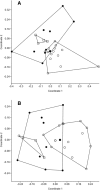Age-related variation in the oral microbiome of urban Cooper's hawks (Accipiter cooperii)
- PMID: 30791867
- PMCID: PMC6385412
- DOI: 10.1186/s12866-019-1413-y
Age-related variation in the oral microbiome of urban Cooper's hawks (Accipiter cooperii)
Abstract
Background: Bird species worldwide are affected by trichomoniasis caused by the protist Trichomonas gallinae. In avivorous raptors such as Cooper's hawks (Accipiter cooperii), nestlings are more susceptible than fledglings and adults. Previous research suggested a link between oral pH and susceptibility: the oral pH of fledgling and adult hawks is more than seven times more acidic than that of nestlings. We speculated that this age-specific difference in pH would correspond to age-specific differences in the oral microbiota of Cooper's hawks. We examined the oral microbiomes of 31 healthy, wild Cooper's hawks in Tucson, Arizona (USA). Individuals represented three age classes (nestlings, fledglings, and adults). We designed our study with multiple controls, replicated sampling, mock communities, and stringent quality-controls to address challenges that can limit the inferential quality of microbiome data sets.
Results: Richness of bacterial communities in oral cavities of Cooper's hawks differed as a function of age but not as a function of sex, sampling date, or sampling location. Bacterial communities in oral cavities of nestlings differed from those of fledglings and adults, whereas communities in fledglings and adults did not differ from each other. Communities were similar in males and females and did not differ over the sampling season. Prevalence of acid-producing bacteria in fledgling and adults vs. nestlings is consistent with previous reports of age-specific variation in oral pH, but further research is needed to establish a causal link to pH levels or susceptibility to disease. Analyses of mock communities demonstrated high repeatability and showed that operon number and read abundance were highly correlated.
Conclusions: The oral microbiota of wild Cooper's hawks differs between nestlings and older birds. Variation in the oral microbiome is consistent with differences in oral pH between nestlings and older individuals. Overall our study provides a first perspective on bacterial communities associated with oral cavities of a wild raptor.
Keywords: 16S rRNA; Accipitridae; Bacteria; Porphyromonas; Raptors; Trichomonas; pH.
Conflict of interest statement
Ethics approval and consent to participate
The University of Arizona’s IACUC reviewed and approved all of the activities in our study that involved the capture and handling of adult, fledgling, and nestling Cooper’s hawks (Protocol 12–329). All specimens were collected locally in Tucson, Arizona and followed institutional and local standards for research. It was required that the number of hawks handled be reported to the IACUC at the end of each year.
Consent for publication
Not applicable.
Competing interests
The authors declare that they have no competing interests.
Publisher’s Note
Springer Nature remains neutral with regard to jurisdictional claims in published maps and institutional affiliations.
Figures


Similar articles
-
The potential role of oral pH in the persistence of Trichomonas gallinae in Cooper's Hawks (Accipiter cooperii).J Wildl Dis. 2014 Jan;50(1):50-5. doi: 10.7589/2012-12-322. Epub 2013 Oct 25. J Wildl Dis. 2014. PMID: 24171574
-
Trichomoniasis in Cooper's hawks from Arizona.J Wildl Dis. 1998 Jul;34(3):590-3. doi: 10.7589/0090-3558-34.3.590. J Wildl Dis. 1998. PMID: 9706569
-
Isolation, molecular characterization, and in vitro schizogonic development of Sarcocystis sp. ex Accipiter cooperii from a naturally infected Cooper's hawk (Accipiter cooperii).Parasitol Int. 2017 Apr;66(2):106-111. doi: 10.1016/j.parint.2016.12.002. Epub 2016 Dec 26. Parasitol Int. 2017. PMID: 28033565
-
The oral microbiome and human health.J Oral Sci. 2017;59(2):201-206. doi: 10.2334/josnusd.16-0856. J Oral Sci. 2017. PMID: 28637979 Review.
-
Cooper's Dictionary of Practical Surgery and Encyclopædia of Surgical Science.Br Foreign Med Chir Rev. 1863 Jan;31(61):77-89. Br Foreign Med Chir Rev. 1863. PMID: 30163461 Free PMC article. Review. No abstract available.
Cited by
-
Composition and function of the Galapagos penguin gut microbiome vary with age, location, and a putative bacterial pathogen.Sci Rep. 2023 Apr 1;13(1):5358. doi: 10.1038/s41598-023-31826-y. Sci Rep. 2023. PMID: 37005428 Free PMC article.
-
Vertically transmitted microbiome protects eggs from fungal infection and egg failure.Anim Microbiome. 2021 Jun 16;3(1):43. doi: 10.1186/s42523-021-00104-5. Anim Microbiome. 2021. PMID: 34134779 Free PMC article.
-
The microbiome of African penguins (Spheniscus demersus) under managed care resembles that of wild marine mammals and birds.Sci Rep. 2023 Oct 4;13(1):16679. doi: 10.1038/s41598-023-43899-w. Sci Rep. 2023. PMID: 37794122 Free PMC article.
-
The gut microbiota in the common kestrel (Falco tinnunculus): a report from the Beijing Raptor Rescue Center.PeerJ. 2020 Dec 1;8:e9970. doi: 10.7717/peerj.9970. eCollection 2020. PeerJ. 2020. PMID: 33344069 Free PMC article.
-
The fecal microbiota of wild and captive raptors.Anim Microbiome. 2020 May 6;2(1):15. doi: 10.1186/s42523-020-00035-7. Anim Microbiome. 2020. PMID: 33499952 Free PMC article.
References
-
- Naldo JL, Samour JH. Causes of morbidity and mortality in falcons in Saudi Arabia. J Avian Med Surg. 2004;18:229–241. doi: 10.1647/2002-013. - DOI
MeSH terms
LinkOut - more resources
Full Text Sources

